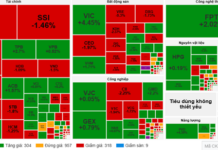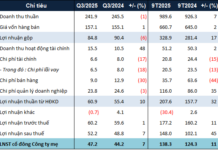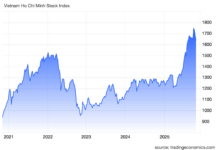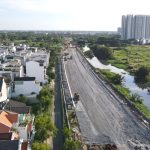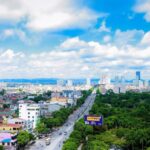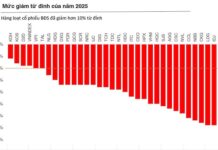Resolution 98/2023 of the National Assembly, effective from August 1, 2023, allows Ho Chi Minh City to pilot the TOD (Transit-Oriented Development) model. This innovative approach aims to enhance urban development by prioritizing public transportation.
Selecting 3 stations for a practical approach:
The TOD model will be applied to urban railway lines and the Ring Road 3. This involves increasing land-use efficiency and population density around metro stations to attract and serve residents. Consequently, there will be a higher demand for commuting in these areas, leading to increased metro usage, reduced traffic congestion, and a boost in ridership for urban railways.
However, after a year, Ho Chi Minh City has not yet implemented the TOD model for urban railways or Ring Road 3. Providing feedback on this matter, Dr. Vu Anh Tuan, Director of the Vietnam-Germany Transportation Research Center at the Vietnam-Germany University, suggested that the city should focus on the Ben Thanh – Suoi Tien metro line (Metro Line 1) to determine the station for TOD development.
Metro Line 1 has 3 potential stations for TOD development: Phuoc Long Station, integrated with the Truong Tho area; Rach Chiec Station, combined with the Rach Chiec Sports Complex and the redevelopment of the northern area; and Suoi Tien Station, linked to the new Eastern Bus Station, revitalizing the area and improving transportation at the city’s gateway.
With these 3 stations, the Departments of Planning and Architecture, Transportation, and Natural Resources and Environment can collaborate to implement detailed planning, design, investment models, and organize bidding, thereby creating significant value for Ho Chi Minh City.
According to Dr. Vu Anh Tuan’s calculations, successfully implementing TOD at these 3 stations can bring billions of USD to the city, providing capital for other lines and offering practical insights from theory to reality. He also proposed that the revenue generated from TOD development should be channeled into a common fund for the city’s urban railway development, potentially offsetting less profitable lines without relying on central government policies.
Agreeing with this approach, Dr. Tran Du Lich, Chairman of the Advisory Council for the implementation of Resolution 98, suggested that land-use rights should be auctioned, and the proceeds used to fund the project, rather than relying on the general budget. Ho Chi Minh City can issue bonds to compensate for expropriation and then repay them once the TOD project is completed.

Metro Line 1 possesses the necessary elements to pioneer the TOD model. Photo: HOANG TRIEU
Balancing Interests:
Architect and Professor Ngo Viet Nam Son acknowledged that Resolution 98 and subsequent resolutions of the Central Government have provided Ho Chi Minh City with a direction for TOD development. However, to turn this vision into reality, numerous regulations related to land auctions and expropriation need to be reformed.
Citing the famous saying, “if you have 8 hours to cut down a tree, spend 4 to 6 hours sharpening the axe,” Professor Nam Son advised: “If we have 11 years to build 180 km of metro, let’s boldly invest 3 to 4 years in completing the Metro Line 1 with a well-defined TOD approach. This includes ensuring seamless bus connections and attracting a large number of daily passengers, resulting in tangible socio-economic benefits. From there, we can replicate this model across other lines.”
Experts also emphasized the need for community consensus in the areas where TOD will be implemented. This model requires strong collaboration between government agencies, investors, and the local community. “To succeed with TOD, it is crucial to have the agreement of the residents regarding land expropriation,” remarked Associate Professor and Arbitrator Vo Tri Hao of the Vietnam International Arbitration Centre (VIAC)
Regarding rapid implementation solutions, Dr. Nguyen Si Dung, former Vice Chairman of the National Assembly Office, suggested that Ho Chi Minh City should establish a land expropriation mechanism for TOD, ensuring a balanced distribution of land rent among the state, enterprises, and citizens. This would expedite the availability of clean land for auction and attract strategic investors…
On August 3, the Ho Chi Minh City People’s Committee held the 5th meeting of the Advisory Council for the implementation of Resolution 98. The meeting reviewed the city’s one-year journey in executing Resolution 98 and discussed solutions and approaches for mechanisms and policies that have not yet been implemented.
Envisioning the Future:
Vice Chairman of the Ho Chi Minh City People’s Committee, Vo Van Hoan, emphasized that implementing TOD involves integrating projects with transportation infrastructure development. Additionally, when approaching TOD, it is crucial to separate compensation from the project and establish it as an independent project.
According to Mr. Vo Van Hoan, the city has not yet achieved this separation. Therefore, the Planning and Transportation Departments must provide consultations to the People’s Committee on a comprehensive TOD development proposal, encompassing major projects, solutions, and implementation methods.
“Along with the state’s investment in compensation for land expropriation and project execution, there are also opportunities to mobilize private resources, coupled with housing and urban development when implementing TOD,” suggested Mr. Vo Van Hoan.
Comprehensive regional connectivity
In addition to building strong physical infrastructure, Ho Chi Minh City needs to strengthen its soft connections with other provinces in the region in order to promote economic development. This includes prioritizing the training of skilled workforce and ensuring access to quality healthcare.

